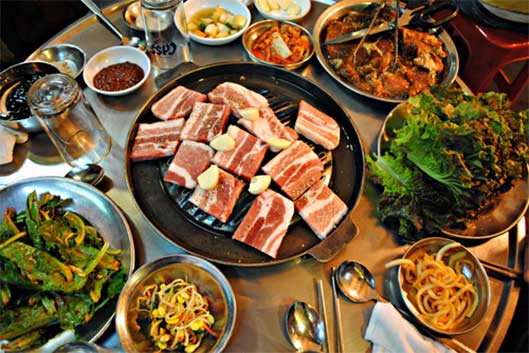
Samkeupsal
Samkeupsal (삼겹살; Korean pronunciation: [samɡjʌp̚sal]) is a popular Korean dish. Commonly served as an evening meal, it consists of thick, fatty slices of pork belly meat (similar to uncured bacon). The meat, usually neither marinated nor seasoned, is cooked on a grill at the diners’ table. Usually diners grill the meat themselves and eat directly from a grill. It is often dipped into a spicy pepper paste.
Popularity in Korea
According to a 2006 survey by Agricultural Cooperatives in Korea (농업협동조합), 85% of South Korean adults surveyed stated their favorite pork is samkeupsal. The survey also showed 70% of recipients eat the meat at least once a week. The high popularity of samkeupsal makes it one of the most expensive parts of pork. South Korea imports wholesale samkeupsal from Belgium, the Netherlands, and other countries for the purpose of price stabilization as imported pork is much cheaper than domestic.
The South Korean government planned to import 70,000 t of samkeupsal with no tariff in the second half year of 2011. Thus, importation of samkeupsal was expected to expand. Samkeupsal is popularly consumed both at restaurants and at home, and also used as an ingredient for other Korean dishes, such as kimchi jjigae.
Accompaniments
The most common accompaniments for samkeupsal are lettuce (sangchu; 상추) and sliced raw garlic, but very often the meat is served with other accompaniments, such as perilla leaves (kkaennip; 깻잎), sliced green chili peppers, shredded green onions, sliced raw onions, and aged kimchi (mugeunji; 묵은지). Garlic, onions, and kimchi can be either grilled with the meat or consumed raw with the cooked meat. Mushrooms, such as button mushrooms or oyster mushrooms, are also grilled with the meat.
Dipping Sauce
Samkeupsal is almost always served with at least two kinds of dipping sauces. One is ssamjang (쌈장), a paste consisting of chili paste (gochujang; 고추장), soybean paste (doenjang; 된장), sesame oil (참기름), and other ingredients; the other is gireumjang (기름장), made with salt and sesame oil, sometimes also with a small amount of black pepper. Usually ssamjang is used when a diner eats samkeupsal with vegetable accompaniments, and gireumjang when a diner wants to taste the cooked meat itself.


